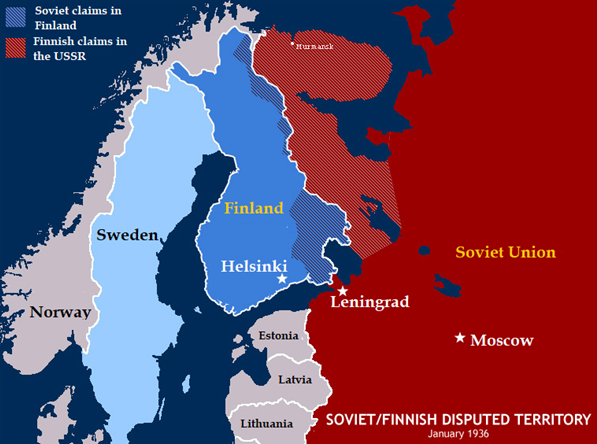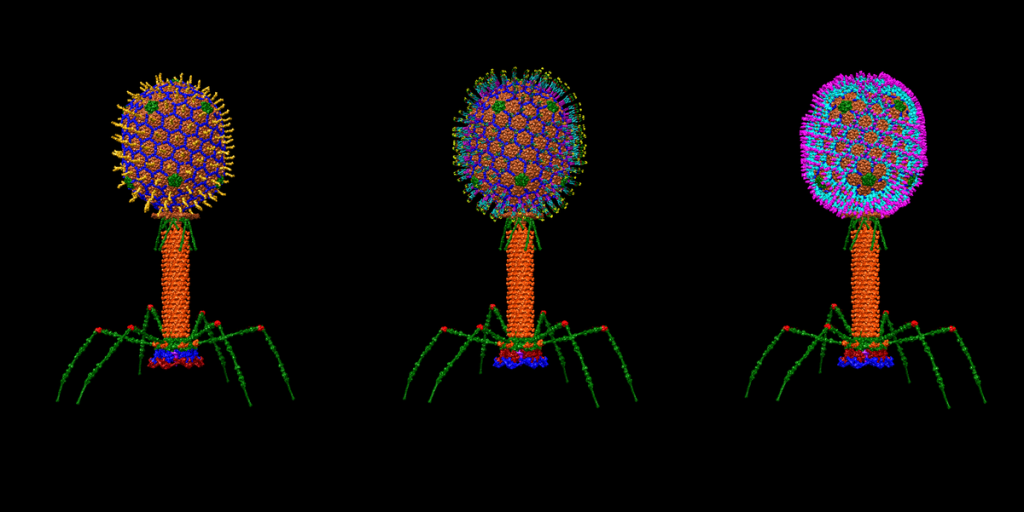This week we are going to take a look at the Winter War. What does a war have to do with our nature and Arctic theme? Well, part of this war was in the Arctic, covering that bit, but the nature/climate aspect is also a lot bigger than you may expect. This war, no doubt filled with skill, pluckiness, tragic loss and many complex reason for its outcome, was heavily influenced by the climate and environment where it happened. Here we will have an overview of this significant war between Finland and the then Soviet Union, including the political history, the effects of weather and terrain, and ultimately why this war had the surprising unfoldment that it did.

The Political Bit
Let’s set the scene. Following the First World War, the Soviet Union (or USSR, now Russia) was under the leadership of Vladimir Lenin, who formed the Red Army with the aim to support “the coming Socialist Revolution in Europe”1. In 1939, Nazi-Germany and the Soviet Union, then under Joseph Stalin, signed a non-aggression pact which included a secret protocol where the two powers essentially divided the continent between them, with the Soviets having jurisdiction over the Baltic States2. Soon after the Soviet Union forced Latvia, Lithuania and Estonia to sign Mutual Assistance Treaties, allowing the Red Army to build military bases within these countries’ borders3,4,5,6. The Soviet Union’s major city of Leningrad (now St Peterburg) lay on the vulnerable west coast of the country, so the presence of Soviet military in these surrounding Baltic States helped to provide a protective buffer around the city.
Throughout all the pact signing and tensions towards the beginning of the Second World War, Finland had tried to remain neutral, and had a non-aggression pact with the USSR. However, the Finns were also well aware of the impacts of Soviet purges and perhaps felt great unease at too much Soviet presence within their borders. There were some discussions back and forth about Mutual Assistance Treaties and potential compromises, but eventually a similar military pact was not signed with Finland6, restricting the Stalin’s defensive buffer in this region.
In November 1939 a border guard post in Mainila in the Soviet Union, was reported to have been shelled killing four guards6,7. Whilst now both Finnish and Russian historians have concluded that this was actually done by the Soviets, it fulfilled its purpose as a deception at the time6,7,15. The Soviet Union blamed Finland for the attack and sent troops into the country. The Winter War had begun.

The Environmental Bit
At the time, Finland had a population of 3.7 million, whilst the Soviet Union had 168.5 million. Of course, some of these Soviet inhabitants lived far away in East Asian Siberia, but as a nation they vastly outnumbered the Finns, and had far better military equipment. The Finns had a tiny air force, just over a hundred planes, and their number of tanks were in the tens, which they didn’t even have the resources to run. The Soviets on the other hand had planes and tanks in the thousands, so it was expected to be a swift and total invasion that would take just a few weeks7,8. The Soviets were so confident they were apparently even warned by their superiors to not accidentally cross the Swedish border on the other side of Finland when they swept through the country9. However, they hadn’t counted on the Finnish army, and crucially the environment and climate in the region, so when they advanced over the borders that winter, things very much did not go to plan.
The Soviets had decided to invade Finland by tank, yet this proved problematic as Finland was covered in snow, forest and swamps. Especially in the area between the two nations there was very little infrastructure, with almost no roads or dirt/gravel tracks10. In fact, the majority of the border was impassable, so the Finns worked out the few crossover points and concentrated their defensive efforts there. When the tanks rumbled into view, the Finns simply stuck logs and crowbars in their way to immobilise them and then attacked at close range9. Their ammunition supplies were low, but they filled glass bottles with alcohol, put in a few matches and threw these at the advancing army, an invention they called the Molotov cocktail after Soviet Foreign Minister Vyacheslav Molotov.
The Soviets tried to advance over frozen water bodies like lakes and rivers, but the Finns simply shot through the ice, causing the heavy machinery to fall in and the attacking forces to drown. Whilst the Soviets trundled through open areas where their tanks would fit, the Finnish army who was highly skilled on skis hid in the forests and picked off the exposed enemy, with one individual, Simo Häyhä, said to have singlehandedly killed over 500 men 7,10,11. The Finns wore warm winter clothing, camouflaged white in colour to blend in with the snow. The Soviets wore khaki uniforms that stood out clearly, and didn’t even get snowsuits until a few months later9. The Finns knew the terrain and climate, and had suitable equipment. Many of the Soviets weren’t used to this cold winter, with temperatures going as low as -40 oC (-40F), and had to sleep in improvised shelters. Scores experienced frostbite, even before entering Finland, whilst others starved and froze, simply keeping alive in the environment being as much of an ordeal as the fight itself9.
Also crucial is that despite the Soviet Union’s far superior air force compared to Finland, due to weather conditions they were unable to deploy planes early in the war12. In the far north above the treeline, the Soviet tanks had more room to move but had even more extreme climatic conditions to contend with, so a Finnish army skilled in survival in that climate, and a fifth of the size of the Soviet army, were able to stop their advance.

The end
Whilst the effectiveness of Finnish resistance was a big surprise to all, the Soviet Union didn’t end up losing the war. Once February came around, a combination of growing experience, refined tactics, far greater amounts of ammunition and sheer numbers allowed them to advance into Finland in the south. The Finnish army was becoming exhausted, and the Soviet Union was suffering a great embarrassment that their army had taken such a beating, so in March 1940 the two sides came together signing the Moscow Peace Treaty. This involved Finland handing over large tracts of Karelia, 11% of the country’s land much of which Russia still holds today. The Winter War also had wider impacts for the ongoing World War as a whole, with Finland’s ability to resist giving Germany the mistaken belief that they could successfully invade the Soviet Union in 194110.
Overall Finland held out for 105 days against the USSR. Reports of Soviet losses vary widely from around 48,000-126,0009,13, with many more missing and wounded, whilst the Finns were thought to have around 25,000 dead or missing14. Whilst these stats were strongly to the ‘advantage’ of the Finns, it should be noted that this was a tragic loss of life overall, no matter the nationality.
Despite the war ending on Soviet terms, it is widely seen as a victory for Finland, though one can easily argue that in war there are no real winners. The reasons for the Soviet defeat are of course multifaceted and we have only given them simple coverage here. Stalin had recently had a purge of his military leaders, getting rid of many who were competent at war but not deemed loyal enough, and had replaced them with completely loyal but questionably skilled new military leaders7,12. This meant that tactics were often a mess with many aspects of geography, training in winter skills and provision of winter equipment being neglected, whereas the Finn’s were acclimatised, organised, well trained, and aware of their skills and weaknesses, such as making the most of skilled marksmanship in the guerrilla-style warfare that took place for much of the Winter War10,12. The Finns also had voluntary resources, such as the women’s paramilitary Lotta Svärd who not only took on a range of roles to free men up to fight, but although officially unarmed they did have rifles for self protection should they encounter the opposing force.
At the same time, the environment played a big factor. No matter the fighting skills, to wage war in an area it was essential to be able to move across the landscape, to stay warm and well rested, to keep up energy and moral, to have sufficient food, to have the experience and mental fortitude for long dark winter nights etc… Climate, morale, leadership, equipment, skill of the enemy, all these and more played a role in the unfoldment and outcome of the Winter War.

We have somewhat of a habit of compartmentalising knowledge, separating arts and sciences, music from politics and so on. In the real world however, all these things are interlinked, and nearly everything we do on Earth is interlinked with the natural environment. War isn’t just based on tech and fighting skills, it depends on the structure of the ground on which the battle is fought, the visibility caused by weather, the access to food resources whilst armies are on campaign, the potential for guerrilla warfare in complex protected locations and so on, not even to mention the impacts of wildlife from prey to predators to disease inducing or poisonous creatures. This extends beyond military activities too, as so many parts of our everyday lives are tightly interlinked with the condition of the natural world. From food, travel, work and recreation, it doesn’t matter if you are not an environmentalist or a nature geek, we all need to pay attention to the natural world.
For more info:
A short article and photo gallery from the winter war (note: readers may find some images disturbing)
A basic video on the winter war:
Music: kongano.com
Title Image: Military Museum of Finland/ CC BY-SA 4.0
Update: This plog was updates on 12/03/2022 to include more extensive referencing and nuanced details.
Bibliography:
1Council of People’s Commissars. 1918. Appendix 1 – “The Scheme for a Socialist Army”, The Red Army (decree). Available: https://web.archive.org/web/20110721180213/http:/www.marxistsfr.org/history/ussr/government/red-army/1937/wollenberg-red-army/append01.htm [Accessed: 11/03/2022]
2The Molotov-Ribbentrop Pact. 1939. Fordham University. Available: https://sourcebooks.fordham.edu/mod/1939pact.asp [Accessed: 11/03/2022]
3Soviet-Estonian Mutual Assistance Treaty. 1939. League of Nations Treaty Series, 198, pp. 224-229.
4Soviet-Latvian Mutual Assistance Treaty. 1939. League of Nations Treaty Series, 198, pp. 382-384.
5Soviet-Lithuania Mutual Assistance Treaty. 1939. League of Nations Treaty Series, 198, pp. 385-387.
6Kallas, H. and Nickels, S. 1968. Finland: Creation and Construction. George Allen and Unwin Ltd. pp 51-52
7Reis, T. 1988. Cold Will: the Defence of Finland. Brassey’s Defence Publishers. pp. 77-91
8Spring, D.W. 1986. The Soviet Decision for War against Finland, 30 November 1939. Soviet Studies, 38(2), pp. 207-226.
9Trotter, W.R. 2002. The Winter War: The Russo–Finnish War of 1939–40 (5th ed.). Aurum Press. pp. 34, 72-73, 145-146, 263-270.
10Department of the Army. 1951. Warfare in the Far North. Department of the Army Pamphlet no. 20-292. Washington
11Saarelainen, T.A.M. 2016. Sankarikorpraali Simo Häyhä. Apali Oy
12Tuunainen, P. 2016. Finnish Military Effectiveness in the Winter War, 1939-1940, London: Palgrave Macmillan pp. 1-6
13Krivosheyev, Grigoriy (1997). Soviet Casualties and Combat Losses in the Twentieth Century (1st ed.). Greenhill Books
14Kurenmaa, P. and Lentilä, R. 2005. “Sodan tappiot”. In Leskinen, J. and Juutilainen, A. (eds.). Jatkosodan pikkujättiläinen. pp. 1150–1162
15Turtola, M. 1999. “Kansainvälinen kehitys Euroopassa ja Suomessa 1930-luvulla”. In Leskinen, J. and Juutilainen, A. (eds.). Talvisodan pikkujättiläinen. pp. 44–45.




Leave a comment